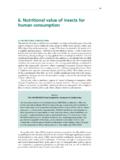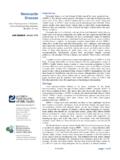Transcription of SECTION Protein Structure and Function I
1 27 ISECTIONP rotein Structure and FunctionCHAPTER 2 Protein StructureCHAPTER 3 Protein 272/15/11 7:50 AM Jones & Bartlett Learning, LLC. NOT FOR SALE OR DISTRIBUTION 28 2 Protein StructureOUTLINE OF The -Amino Acids -Amino acids have an amino group and a carboxyl group attached to a central carbon acids are represented by three-letter and one-letter The Peptide Bond -Amino acids are linked by peptide Protein PurificationProtein mixtures can be fractionated by and other charged biological polymers migrate in an electric Primary Structure of ProteinsThe amino acid sequence or primary Structure of a purified Protein can be sequences can
2 Be obtained from nucleic acid BLAST program compares a new polypeptide sequence with all sequences stored in a data with just one polypeptide chain have primary, secondary, and tertiary structures while those with two or more chains also have quaternary Weak Noncovalent BondsThe polypeptide folding pattern is determined by weak non-covalent Secondary StructuresThe -helix is a compact Structure that is stabilized by hydrogen -conformation is also stabilized by hydrogen and turns connect different peptide segments, allowing polypeptide chains to fold back on combinations of secondary structures, called supersecondary structures or folding motifs.
3 Appear in many different cannot yet predict secondary structures with absolute Tertiary StructureX-ray crystallography and nuclear magnetic resonance studies have revealed the three-dimensional structures of many different disordered proteins lack an ordered Structure under physiological genomics is a field devoted to solving x-ray and NMR structures in a high throughput primary Structure of a polypeptide determines its tertiary chaperones help proteins to fold inside the Proteins and Biological MembranesProteins interact with lipids in biological fluid mosaic model has been proposed to explain the Structure of biological membranes.
4 Suggested 282/15/11 7:50 AM Jones & Bartlett Learning, LLC. NOT FOR SALE OR DISTRIBUTIONCHAPTER 2 Protein Structure 29As described in Chapter 1, the Watson-Crick Model helped to bridge a major gap between genetics and biochemistry, and in so doing helped to create the discipline of molecular biol-ogy. The double helix Structure showed the importance of elucidating a biological molecule s Structure when attempting to understand its Function . This chapter and Chapter 3 extend the study of Structure - Function relationships to polypeptides, which catalyze specific reac-tions, transport materials within a cell or across a membrane, protect cells from foreign invaders, regulate specific biological processes, and support various structures.
5 The basic building blocks for polypeptides are small organic mol-ecules called amino acids. Amino acids can combine to form long linear chains known as polypeptides. Each type of polypeptide chain has a unique amino acid sequence. Although a polypeptide must have the correct amino acid sequence to perform its specific biological Function , the amino acid sequence alone does not guarantee that the polypeptide will be biologically active. The polypeptide must fold into a specific three-dimensional Structure before it can perform its biological Function (s).
6 Once folded into its biologically active form, the polypeptide is termed a Protein . Proteins come in various sizes and shapes. Those with thread-like shapes, the fibrous proteins, tend to have structural or mechanical roles. Those with spherical shapes, the globular proteins, Function as enzymes, transport proteins, or antibodies. Fibrous proteins tend to be water-insoluble, while globular proteins tend to be are unique among biological molecules in their flex-ibility, which allows them to fold into characteristic three-dimensional structures with specific binding properties.
7 Mutations that alter a Protein s ability to interact with its normal molecular partners often result in a loss of Protein activity. One of the most common partners of a folded polypeptide is another folded polypeptide, which may be identical to it or different. A complex that contains two, three, or more identical polypeptides is called a homodimer, homotrimer, and so forth, whereas one that contains different polypeptides is called a heterodimer, heterotrimer, and so forth. The `-Amino Acids`-Amino acids have an amino group and a carboxyl group attached to a central carbon atom.
8 The typical amino acid building block for polypeptide synthesis has a central carbon atom that is attached to an amino ( NH2) group, a carboxyl ( COOH) group, a hydrogen atom, and a side chain ( R). At pH 7, the amino group is protonated ( , the addition of a pro-ton) to form NH3+ and the carboxyl group is deprotonated to form COO so that the amino acid has the Structure shown in FIGURE These amino acids are termed `-amino acids in accordance with a H3N+HC COO RFIGURE Structure of an `-amino acid. A typical -amino acid in which the central carbon atom is attached to an amino ( NH3+) group, a carboxylate ( COO ) group, a hydro-gen atom, and a side chain ( R).
9 292/15/11 7:50 AM Jones & Bartlett Learning, LLC. NOT FOR SALE OR DISTRIBUTION 30 SECTION I Protein Structure AND FUNCTIONpre-IUPAC nomenclature system, in which the atoms in a hydrocarbon chain attached to a carboxyl ( COOH) group are designated by Greek letters. The carbon atom closest to the carboxyl group is designated , the next , and so forth. Each amino acid has characteristic physical and chemical proper-ties that derive from its unique side chain. Amino acids with similar side chains usually have similar properties.
10 This relationship is an important consideration when comparing amino acid sequences of two different polypeptides or when considering the effect that an amino acid substitution will have on Protein Function . Based on side chain Structure , amino acids can be divided into four groups. Side Chains with Basic GroupsArginine, lysine, and histidine are called basic amino acids because their side chains are proton acceptors (FIGURE ). The guanidino group in arginine s side chain is a relatively strong base. The amine group in lysine s side chain is a somewhat weaker base, and the imid-azole group in histidine s side chain is the weakest of the three bases.

















